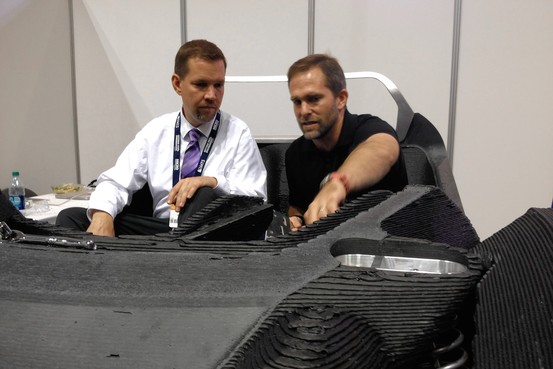
Today, a car is being prepped to go on a groundbreaking first testdrive. In Chicago, Local Motors has taken the helm to achieve the previously considered impossible. How long do you think it takes to build a car? From finding or creating the parts and hooking up giant welding machines to power them, creating an automobile takes a long time. 17 to 18 hours is the estimate on Toyota’s webpage. But then there’s transportation, there’s purchasing the man power and all the other factors start to add up.
Local Motors wants to do it in 10, and with a printer, and within the next year, that may be an option. A car being called Strati, the Italian word for Layer, was printed and will be drivable if all the tests go well. The car is completely electric and can go 100 to 120 miles before needing a recharge to the battery inside. It was printed in 44 hours, but the projections suggest that even within months it will be reduced to 25 hours. After the 10 hour goal within a year, its hard to say what innovations will relieve the manual labor requirements currently in effect today. The windshield, motor, base and tires are manufacture made.
This car doesn’t have to pass all of the standard safety tests that typically restrict vehicles common to us today because Strati has a maximum speed of 40 miles per hour. Going 40 miles an hour will ensure the 100 miles will be well spent, but the question is whether or not the vehicle is cost efficiency. Before the end of this year, Local Motors is going to be producing production-level cars between $18,000 and $30,000. They may vary in size and internal equipment, but the premise is the same. Assembly is just 47 parts.
3D printers have been around for decades. Three decades to be exact. The first, created by Chuck Hull, was working for 3D Systems Corporation and in 1984, the first 3D printed part came into being through a process called stereolithography employing UV lasers to cure photopolymers. (Source and definitions included)
Local Motors wishes to take a democratic and generous approach to this creation. They see the potential jobs that this kind of manufacturing can make and state that this kind of facility could be a huge economic boost for cities, towns and even in individual homes. Will we see factions in cars, for the first time, where families start driving the same exact car that sets them apart from their neighbor’s complete set for their family?
Cars are going to become our accents. The 50 states speak differently and have different customs, but if printing cars becomes commonplace and expensive transportation costs of moving, at most, twenty cars on a big-rig goes out of style, entire states could have their own lines by which they will be recognized.
The cars won’t be restricted to electric either. It’s all in the blue prints. This puts the shame the anti-piracy campaign of, “you wouldn’t download a car.” Now, you’re doing exactly that. You’re hitting print in your garage and a plan you found will be printed in 10 hours in front of you, if you can afford it. Will this allow people with the proper technical know-how to create their own blue prints? There’s plenty of designs, as Strati was taken from over 200 submissions in a competition.
The way you drive is going to change very soon, and it might look like this. (click for larger)


